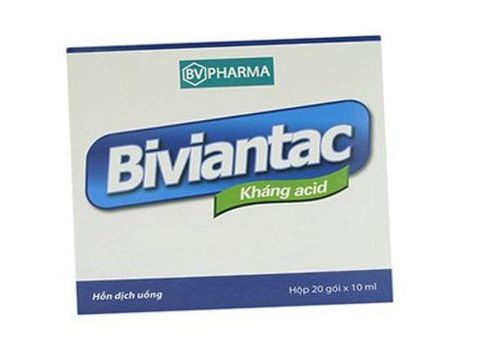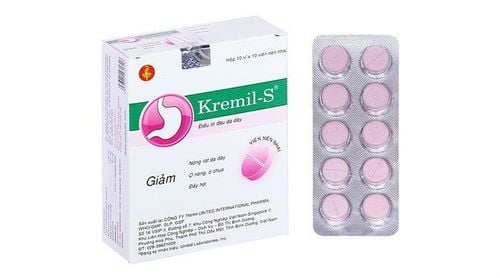This is an automatically translated article.
Atropin is used in the treatment of many different medical conditions. So what is Atropin and how does it work?
1. Effects of Atropine
Atropine has the potential to cause many effects in the body, including reducing smooth muscle spasms and reducing secretions of body fluids (such as saliva, mucus, or other secretions in the respiratory tract). This effect of Atropin helps control medical conditions such as:
Colitis ; Diverticulitis ; Bladder spasms; Colic in infants; Renal and biliary spasms; Peptic ulcer disease ; Irritable bowel syndrome ; Use during surgery to reduce respiratory secretions. Atropin is also used in the following cases:
Treatment of symptoms of tremor, stiffness, salivation and excessive sweating in Parkinson's disease; Certain heart disorders; Control episodes of mood swings caused by brain tumors; Used to dilate the eye pupil in ophthalmology. In some cases, Atropin is also used as an antidote to treat certain types of poisoning.
Atropin is contraindicated in the following cases:
Angle-closure glaucoma; 2nd or 3rd degree atrioventricular block; Esophageal spasm; Intestinal obstruction due to paralytic ileus; Severe ulcerative colitis; Intestinal paralysis ; Acute toxic colitis; pyloric stenosis.
2. Dosage and usage of Atropin
Atropin is produced in two forms:
Oral Atropin (tablets) with a content of Atropin sulfate 0.25mg; Syringe form with concentrations of 0.25 mg/ml and 0.5 mg/ml. The dose of Atropine should be strictly according to the doctor's prescription. Reference doses in specific cases are as follows:
Recommended dose of Atropin for adults:
Treatment of bradycardia: 0.4–1mg IV every 1–2 hours as needed set. In special cases, a maximum dose of up to 2mg can be used; Treatment of atrioventricular block: Use a dose of 0.4–1mg, intravenously, intramuscularly or subcutaneously; Treatment of poisoning with cholinesterase inhibitors: Use a dose of 0.4–0.6mg, intravenously, intramuscularly or subcutaneously; Treatment of organophosphate poisoning or other neurotoxic agents: Use a dose of 0.8 mg intramuscularly. Within 30 minutes of injection, if no obvious effect or toxic symptoms occur (such as nausea, vomiting, diarrhea, pupillary constriction, eye and tongue twitching, pulmonary edema, excessive sweating, excessive salivation and bronchial secretions), administer 2mg of Atropin IM every hour until signs of atropinization. Atropin 2mg dose may be given 2–3 times (4–6mg total) in severe cases; Use for anesthesia/anesthesia, head trauma, gastrointestinal ulcers: Use a dose of 0.4–0.6 mg intravenously, intramuscularly or subcutaneously, the dose may be increased in some cases; Dilating the pupil and causing paralysis of the ciliary muscle in refraction: Use a 1% solution of atropine to drip 1-2 drops into the conjunctiva 40–60 minutes before the measurement; Treatment of iritis, uveitis: Use a 1% solution of atropin medicine, drop 1-2 drops into the eye, up to 4 times a day; Treatment of diverticulitis, irritable bowel syndrome, non-ulcer dyspepsia: 0.6–1.2 mg orally before bed, a single dose. Dosage of Atropin for children:
Treatment of bradycardia: Use a starting dose of 0.02mg/kg/time, intravenously, can be repeated every 5 minutes, maximum dose is 0.5mg . Treatment of organophosphorus poisoning: Use an initial dose of 0.05–0.1 mg/kg intravenously or intramuscularly every 5–10 minutes until signs and symptoms of toxicity disappear. Anesthesia : Atropin is used intravenously or subcutaneously 30-60 minutes before anesthesia with the following dose: Children under 3kg: Use a dose of 0.1mg; Children 7–9 kg: Use a dose of 0.2mg; Children 12–16kg: Use a dose of 0.3mg; Younger than 20kg: Use dose 0.4–0.6mg. Pupil dilation and paralysis of the eyelid muscles when measuring refraction: Use a 1% solution of atropin to drop 1 drop in each eye, 2 times a day for about 1–3 days before taking the measurement; Treatment of iritis, uveitis: Use a 1% solution of atropin to drop 1 drop in each eye, up to 3 times a day. When using an overdose of Atropin, you may experience the following symptoms:
Headache; Nausea, vomiting; Dry mouth, nose or throat; Increased breathing rate; Blurred vision; Pupil dilation; Hyperthermia ; Dry skin; Dizzy; Sleepy; Not alert, or confused; Concerned; Convulsions; Weak pulse; Abnormal heart rate. At this point you need to seek emergency medical help.
3. Side Effects of Atropin Most Atropin side effects are caused by an overactive effect of the drug on the muscarinic-cholinergic receptors and these symptoms are reversible upon discontinuation of the drug. The severity and frequency of adverse events with atropine are related to individual dose and tolerability.
Some common side effects of Atropin include:
Dry mouth; Dry skin ; Blurred vision; Paralysis of the ciliary body; Pupil dilation; Fear of light; Reduce sweating; Urinary frequency, urgency, or urinary retention; Tachycardia, palpitations; Dry eyes ; Constipation. Some patients experience serious side effects of Atropin that can lead to death such as:
Asystole; Atrioventricular arrhythmias; Atrial fibrillation; Atrioventricular dissociation; Ventricular tachycardia ; Respiratory failure; Comatose; Angioedema (rarely occurs). 4. Interactions of Atropin with other drugs Some drugs that can interact with Atropin are:
Ipratropium; Diphenhydramine; Hydromorphone; Haloperidol; Hyoscyamine; Morphine; Neostigmine; Paracetamol ; Promethazine; Scopolamine; Pralidoxime. You should talk to your doctor when using these drugs together with Atropin.
Please dial HOTLINE for more information or register for an appointment HERE. Download MyVinmec app to make appointments faster and to manage your bookings easily.













